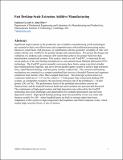| dc.contributor.author | Go, Jamison | |
| dc.contributor.author | Hart, Anastasios John | |
| dc.date.accessioned | 2020-11-18T23:23:30Z | |
| dc.date.available | 2020-11-18T23:23:30Z | |
| dc.date.issued | 2017-12 | |
| dc.date.submitted | 2017-10 | |
| dc.identifier.issn | 2214-8604 | |
| dc.identifier.uri | https://hdl.handle.net/1721.1/128535 | |
| dc.description.abstract | Significant improvements to the throughput of additive manufacturing (AM) processes are essential to their cost-effectiveness and competitiveness with traditional processing routes. Moreover, high-throughput AM processes, in combination with the geometric versatility of AM, will enable entirely new workflows for product design and customization. We present the design and validation of a desktop-scale extrusion AM system that achieves a much greater build rate than benchmarked commercial systems. This system, which we call ‘FastFFF’ is motivated by our recent analysis of the rate-limiting mechanisms to conventional fused filament fabrication (FFF) technology. The FastFFF system mutually overcomes these limits, using a nut-feed extruder, laser-heated polymer liquefier, and servo-driven parallel gantry system to achieve high extrusion force, rapid filament heating, and fast gantry motion, respectively. The extrusion and heating mechanisms are contained in a compact printhead that receives a threaded filament and augments conduction heat transfer with a fiber-coupled diode laser. The prototype system achieves a volumetric build rate of 127 cm 3 /hr, which is approximately 7-fold greater than commercial desktop FFF systems, at comparable resolution; the maximum extrusion rate of the printhead is ∼14-fold greater (282 cm 3 /hr) than our benchmarks. The performance limits of the printhead and motion systems are characterized, and the tradeoffs between build rate and resolution are assessed and discussed. High-speed desktop AM raises the possibility of new use cases and business models for AM, where handheld parts are built in minutes rather than hours. Adaptation of this technology to print high-temperature thermoplastics and composite materials, which require high extrusion forces, is also of interest. | en_US |
| dc.language.iso | en | |
| dc.publisher | Elsevier BV | en_US |
| dc.relation.isversionof | http://dx.doi.org/10.1016/j.addma.2017.10.016 | en_US |
| dc.rights | Creative Commons Attribution-NonCommercial-NoDerivs License | en_US |
| dc.rights.uri | http://creativecommons.org/licenses/by-nc-nd/4.0/ | en_US |
| dc.source | arXiv | en_US |
| dc.title | Fast Desktop-Scale Extrusion Additive Manufacturing | en_US |
| dc.type | Article | en_US |
| dc.identifier.citation | Go, Jamison and A. John Hart. "Fast Desktop-Scale Extrusion Additive Manufacturing." Additive Manufacturing (December 2017): 276-284. © 2017 Elsevier B.V. | en_US |
| dc.contributor.department | Massachusetts Institute of Technology. Department of Mechanical Engineering | en_US |
| dc.contributor.department | Massachusetts Institute of Technology. Laboratory for Manufacturing and Productivity | en_US |
| dc.relation.journal | Additive Manufacturing | en_US |
| dc.eprint.version | Original manuscript | en_US |
| dc.type.uri | http://purl.org/eprint/type/JournalArticle | en_US |
| eprint.status | http://purl.org/eprint/status/NonPeerReviewed | en_US |
| dc.date.updated | 2019-09-25T14:31:49Z | |
| dspace.date.submission | 2019-09-25T14:31:52Z | |
| mit.journal.volume | 18 | en_US |
| mit.metadata.status | Complete | |
